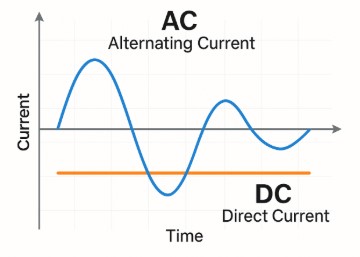What is AC (Alternating Current)?

Alternating Current (AC) is a form of electricity where the flow of electrons reverses direction periodically, unlike Direct Current (DC), where the flow is unidirectional. AC is the standard for power transmission and distribution worldwide due to its ability to travel long distances efficiently and be transformed into different voltages using transformers. Alternating current has:
- Waveform: AC typically follows a sinusoidal wave, allowing for smooth and consistent power delivery.
- Frequency: Commonly 50 Hz (cycles per second) in most of the world, 60 Hz in regions like North America.
- Voltage: Constantly rises and falls, changing polarity at each half-cycle.
Callout: The Current That Reverses Direction—But Never Drops Power
Alternating Current (AC) reverses direction many times per second (typically 50 or 60 times), but devices don’t lose power because the energy delivered is measured by the root mean square (RMS) value of the waveform, not its direction. The voltage rises and falls in a smooth sine wave, and although the direction of flow changes, the amount of usable power remains constant. This is why AC can efficiently power appliances, lights, and motors—even while continuously changing direction.
How Does AC Work?
AC works on the principle of electromagnetic induction, discovered by Michael Faraday. An alternator (AC generator) spins a coil of wire inside a magnetic field, inducing an oscillating electric current.
AC is generated by devices known as alternators or AC generators, which operate using electromagnetic induction.
AC Generation:
- A coil spins within a magnetic field (or vice versa).
- This induces an oscillating voltage as per Faraday’s Law.
- The output is a sinusoidal waveform (usually 50Hz or 60Hz depending on the country).
Characteristics:
- Polarity Reversal: Voltage switches between positive and negative at regular intervals.
- Amplitude: Indicates the peak voltage.
- Frequency: Number of cycles per second (Hertz).
- Phase: In multi-phase systems (e.g., 3-phase), voltage waveforms are offset in time.
In Grid Usage:(give link for ac grid wiki)
- AC voltage is stepped up using transformers for transmission, and stepped down before distribution.
- AC can be easily regulated, switched, and converted using simple or advanced electronics.
Applications of AC Power
AC powers nearly all public and commercial infrastructure. Its ability to transform into various voltages makes it versatile for small devices and large systems alike.



